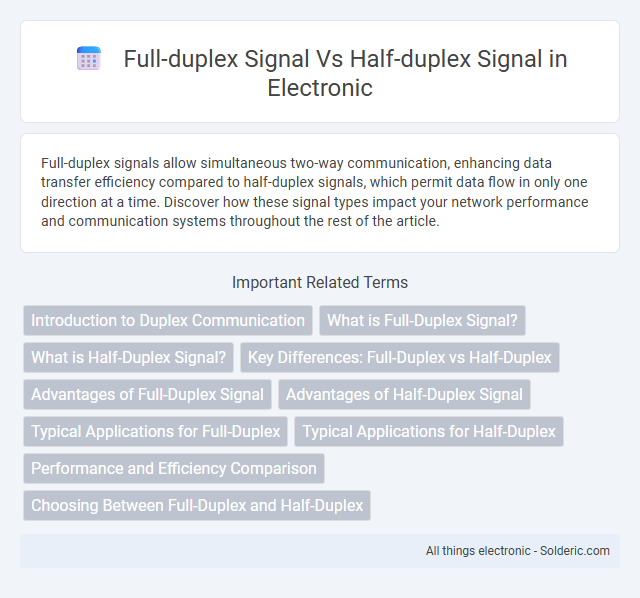Full-duplex signals allow simultaneous two-way communication, enhancing data transfer efficiency compared to half-duplex signals, which permit data flow in only one direction at a time. Discover how these signal types impact your network performance and communication systems throughout the rest of the article.
Comparison Table
| Feature | Full-Duplex Signal | Half-Duplex Signal |
|---|---|---|
| Communication Direction | Simultaneous two-way | Two-way, but one direction at a time |
| Data Transmission | Continuous, simultaneous send and receive | Alternating send and receive |
| Latency | Low latency due to concurrent communication | Higher latency; wait time during switch |
| Complexity | Higher complexity in hardware and protocol | Lower complexity, simpler design |
| Bandwidth Utilization | More efficient; full bandwidth used both ways | Less efficient; bandwidth shared alternately |
| Typical Applications | Telephones, modern Ethernet switches | Walkie-talkies, traditional Ethernet hubs |
Introduction to Duplex Communication
Duplex communication enables simultaneous or alternate transmission of signals between two devices, with full-duplex allowing data to flow in both directions at the same time, while half-duplex supports communication in only one direction at a time. Full-duplex systems, like telephone networks, improve efficiency and speed by eliminating wait times for sending or receiving data. Understanding the distinction between full-duplex and half-duplex signals can help you optimize network design and enhance communication performance.
What is Full-Duplex Signal?
Full-duplex signal communication allows simultaneous two-way transmission of data between devices, effectively doubling the communication capacity compared to half-duplex systems. Unlike half-duplex signals, where data flows in only one direction at a time, full-duplex technology enables continuous and concurrent sending and receiving of signals, improving network efficiency and reducing latency. Your network can achieve better performance and faster response times by implementing full-duplex signaling in applications such as telecommunication and Ethernet connections.
What is Half-Duplex Signal?
A half-duplex signal allows communication in both directions but only one direction at a time, meaning devices take turns transmitting and receiving. This type of signal is commonly used in walkie-talkies and two-way radios, enabling efficient use of a single communication channel. Your system may benefit from half-duplex signaling when simultaneous two-way communication is unnecessary, reducing complexity and bandwidth requirements.
Key Differences: Full-Duplex vs Half-Duplex
Full-duplex signal systems transmit and receive data simultaneously, enabling continuous two-way communication and significantly improving the efficiency and speed of data exchange. Half-duplex signal systems allow data transmission in both directions but only one direction at a time, causing potential delays as devices must wait to switch between sending and receiving modes. Full-duplex is commonly used in telephone networks and modern Ethernet, while half-duplex is often found in walkie-talkies and traditional two-way radios.
Advantages of Full-Duplex Signal
Full-duplex signal systems enable simultaneous two-way communication, doubling data transmission efficiency compared to half-duplex systems that allow communication in only one direction at a time. This capability reduces latency and enhances real-time interaction, crucial for applications like video conferencing and VoIP services. Full-duplex systems improve bandwidth utilization and provide smoother, more reliable network performance, especially in high-demand environments.
Advantages of Half-Duplex Signal
Half-duplex signals offer the advantage of simplified communication protocols by allowing transmission in both directions, but never simultaneously, reducing the complexity of hardware design. This mode effectively prevents collisions in cases where the communication channel is shared, enhancing reliability in environments with limited bandwidth. Half-duplex systems are typically more cost-effective and energy-efficient compared to full-duplex alternatives, making them suitable for applications like walkie-talkies and legacy network configurations.
Typical Applications for Full-Duplex
Full-duplex signals enable simultaneous two-way communication, making them ideal for telecommunication systems, such as telephone networks and video conferencing, where real-time interaction is crucial. They are extensively used in Ethernet networks supporting high-speed data transfer and in wireless communication protocols like LTE and 5G to enhance bandwidth efficiency. Full-duplex technology also powers modern VoIP services, enabling seamless voice communications without transmission delays.
Typical Applications for Half-Duplex
Half-duplex signals are commonly used in walkie-talkies, CB radios, and two-way radio communication systems where signals can travel in both directions, but only one direction at a time. These systems prioritize simplicity and cost-effectiveness, making them ideal for emergency services, construction sites, and military operations. Your communication setup can benefit from half-duplex technology if you require reliable, intermittent two-way communication without the complexity of full-duplex systems.
Performance and Efficiency Comparison
Full-duplex communication allows simultaneous two-way data transmission, doubling effective bandwidth and reducing latency compared to half-duplex systems, which alternate between sending and receiving signals. This continuous bidirectional flow enhances network throughput and minimizes collisions, making full-duplex ideal for high-performance applications like Ethernet switching. Half-duplex systems, while simpler and less costly, suffer from increased delays and lower channel efficiency due to time-sharing constraints and collision handling mechanisms.
Choosing Between Full-Duplex and Half-Duplex
Choosing between full-duplex and half-duplex signals depends on your communication needs and system capabilities. Full-duplex allows simultaneous two-way communication, ideal for real-time applications requiring seamless data exchange, while half-duplex supports one direction at a time, conserving bandwidth and reducing complexity. Assessing factors like network traffic, latency sensitivity, and hardware costs can guide optimal selection for robust and efficient communication.
full-duplex signal vs half-duplex signal Infographic

 solderic.com
solderic.com